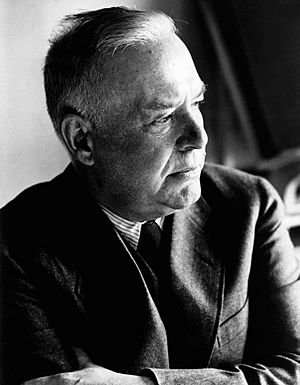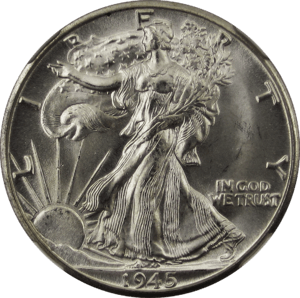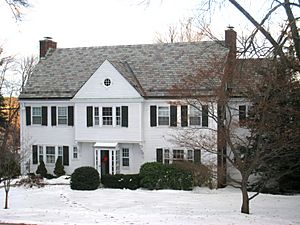Wallace Stevens facts for kids
Quick facts for kids
Wallace Stevens
|
|
|---|---|

Stevens in 1948
|
|
| Born | October 2, 1879 Reading, Pennsylvania, U.S. |
| Died | August 2, 1955 (aged 75) Hartford, Connecticut, U.S. |
| Occupation |
|
| Period | 1914–1955 |
| Literary movement | Modernism |
| Notable works | Harmonium "The Idea of Order at Key West" The Man With the Blue Guitar The Auroras of Autumn "Of Modern Poetry" |
| Notable awards | Robert Frost Medal (1951) |
| Spouse | Elsie Viola Kachel (m. 1909–1955) |
| Children | Holly Stevens (1924–1992) |
| Signature | |
Wallace Stevens (born October 2, 1879 – died August 2, 1955) was an American modernist poet. He was born in Reading, Pennsylvania. He studied at Harvard and then New York Law School. For most of his life, he worked as an executive for an insurance company in Hartford, Connecticut. In 1955, he won the Pulitzer Prize for Poetry for his book Collected Poems.
Stevens wrote poetry in different periods of his life. His first major collection, Harmonium, came out in 1923. Later, he wrote three more poetry books: Ideas of Order, The Man with the Blue Guitar, and Parts of a World. These were followed by Transport to Summer. His last major work was The Auroras of Autumn, published in the early 1950s. His Collected Poems was released in 1954, just a year before he passed away.
Some of his most famous poems include "The Auroras of Autumn", "Anecdote of the Jar", "The Emperor of Ice-Cream", "The Idea of Order at Key West", "Sunday Morning", "The Snow Man", and "Thirteen Ways of Looking at a Blackbird".
Contents
Life and Career of Wallace Stevens
Early Life and Education
Wallace Stevens was born in Reading, Pennsylvania, in 1879. His family was Lutheran. His great-grandfather, John Zeller, settled in the Susquehanna Valley in 1709.
Stevens's father was a successful lawyer. Wallace went to Harvard from 1897 to 1900. While in Boston, he met the philosopher George Santayana. Santayana's book Interpretations of Poetry and Religion greatly influenced Stevens. After Harvard, Stevens moved to New York City. He worked briefly as a journalist. He then studied law at New York Law School, graduating in 1903.
Marriage and Family Life
In 1904, Stevens met Elsie Viola Kachel (1886–1963) in Reading. She worked as a saleswoman and stenographer. They married in 1909, even though his parents did not approve. His parents thought Elsie was not educated enough. No one from his family attended the wedding. Stevens never visited or spoke to his parents again during his father's lifetime.
Their daughter, Holly, was born in 1924. Holly later edited her father's letters and poems after he died.
In 1913, the Stevens family rented an apartment in New York City. Their landlord was sculptor Adolph Alexander Weinman. Weinman made a sculpture of Elsie. Her unique profile might have been used on Weinman's 1916–1945 Mercury dime and the Walking Liberty Half Dollar. Later in life, Elsie faced health challenges. This caused difficulties in their marriage, but they stayed together.
Working as a Lawyer and Poet
After working at several law firms in New York, Stevens joined the American Bonding Company in 1908. By 1914, he became vice-president of the New York office for Equitable Surety Company. In 1916, he moved to Hartford and joined the Hartford Accident and Indemnity Company. He stayed there for the rest of his life.
Stevens was a businessman by day and a poet in his free time. His job involved checking surety insurance claims. He would decide if a claim should be paid. If the company was sued, he would hire a local lawyer to handle the case.
In 1917, Stevens and his wife moved to 210 Farmington Avenue. There, he finished his first poetry book, Harmonium. From 1924 to 1932, they lived at 735 Farmington Avenue. In 1932, he bought a house at 118 Westerly Terrace, where he lived until his death. As an insurance executive, Stevens earned a good salary. By the mid-1930s, he made about $20,000 a year. This was a lot of money during the Great Depression.
By 1934, he was named vice-president of his company. After winning the Pulitzer Prize in 1955, Harvard University offered him a teaching job. However, he turned it down because it would mean leaving his job at The Hartford. Stevens was politically conservative throughout his life.
Travels and Famous Encounters
Stevens often visited Key West, Florida, between 1922 and 1940. He usually stayed at the Casa Marina hotel. He loved Key West, calling it "a paradise." The beautiful scenery of Key West inspired many of his poems. These poems appeared in his early collections, Harmonium and Ideas of Order.
In February 1935, Stevens met the poet Robert Frost at the Casa Marina. The next year, Stevens had an argument with writer Ernest Hemingway at a party in Key West. Stevens broke his hand during the fight. He later apologized to Hemingway.
In 1940, Stevens made his last trip to Key West. He met Robert Frost again, and they had another famous argument. Frost said Stevens's poems were "too executive," meaning they sounded like a businessman. Stevens said Frost's poems were "too academic."
Later Poetry and Final Years
By 1947, Stevens, nearing 67, had written many of his best poems. His book Transport to Summer was published that year and was well-received. This book, along with Ideas of Order, The Man with the Blue Guitar, and Parts of a World, showed his great talent. He later wrote the well-known poem The Auroras of Autumn.
In 1950–1951, Stevens learned that his old mentor, George Santayana, was living in a retirement home in Rome. Stevens wrote a poem called "To an Old Philosopher in Rome" in his honor. The poem describes Santayana's simple room and peaceful final days.
Last Illness and Death
Wallace Stevens was a large man, standing 6 feet 2 inches tall and weighing about 240 pounds. In March 1955, he began to feel unwell. Doctors found that he had stomach cancer. This was a very serious diagnosis in the 1950s. Stevens was not told the full details of his illness, but his daughter, Holly, knew.
He was released from the hospital in May and returned home to recover. His wife tried to help him, but she had recently had a stroke. Stevens then went to a convalescent hospital. In June, he was well enough to receive honorary degrees from the University of Hartford and Yale University.
On July 21, Stevens was admitted to St. Francis Hospital again. His health got worse. On August 1, he spoke to his daughter before falling asleep. He passed away the next morning, August 2, 1955. He is buried in Hartford's Cedar Hill Cemetery. Wallace Stevens's life span was almost exactly the same as Albert Einstein's. Both were born in 1879 and died in 1955.
Friends of Stevens knew that he often visited St. Patrick's Cathedral in New York City. He would go there to think and meditate.
Awards and Recognition
During his life, Wallace Stevens received many awards for his poetry. These include:
- Bollingen Prize for Poetry (1949)
- National Book Award for Poetry (1951, 1955) for The Auroras of Autumn and The Collected Poems of Wallace Stevens
- Frost Medal (1951)
- Pulitzer Prize for Poetry (1955) for Collected Poems
See also
 In Spanish: Wallace Stevens para niños
In Spanish: Wallace Stevens para niños



